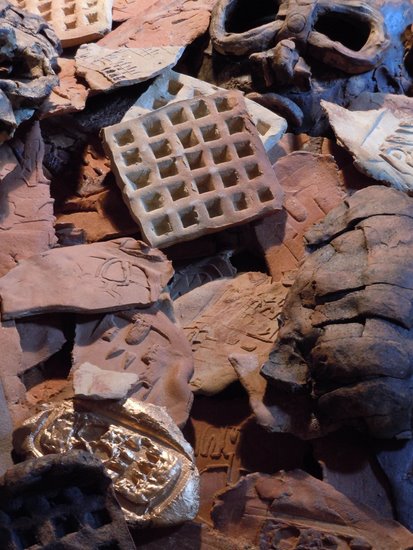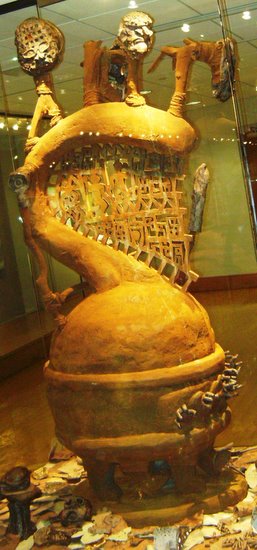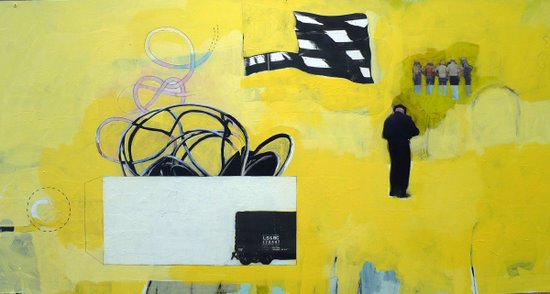 Littering the bottoms of the display cases at the gallery inside the Quad City International Airport is a landfill-like carpeting - a mat of apparent cultural detritus under Steve Banks' sculptures. It initially appears ancient, like scattered pottery shards, but a closer inspection reveals pizza slices, pie crusts, bullets, masks, and chunks of carvings, all out of earthenware clay.
Littering the bottoms of the display cases at the gallery inside the Quad City International Airport is a landfill-like carpeting - a mat of apparent cultural detritus under Steve Banks' sculptures. It initially appears ancient, like scattered pottery shards, but a closer inspection reveals pizza slices, pie crusts, bullets, masks, and chunks of carvings, all out of earthenware clay.
We see this fascination with objects across this exhibit, among the work of both Banks and mixed-media artist Aaron Tinder. The Quad City Arts show - running through August - consists of three large sculptures and four mixed-media canvases by Banks, and eight mixed-media works on paper by Tinder. Their use of familiar objects makes this exhibit accessible, but their mysterious and metaphorical treatment provides depth.
Banks' main sculptures are large and commanding, yet a vast amount of their content can be found in the aforementioned base of "debris." Included are various scraps of low-relief works created in the style of broken parts of Egyptian, Hindu, or pre-Columbian temples. Despite their aged style and appearance, many of these fragments depict modern imagery, such as fast-food cups or skyscrapers. This juxtaposition of ancient and contemporary "relics" seems to reflect on how, through the lens of history, societies are interpreted based on the imagery of their artifacts.
The sculptures - Hydra (Seven Headed), Trojan Horse, and Tower of Babel - share a similar form: a five- to seven-foot-tall subject centered in the display case with this base of assorted objects, appearing as a monolith emerging (or remaining) from rubble. The individual elements of the sculptures are mostly ceramics, with matte under-glazes in shades of brown. Banks also utilizes mixed-media components, such as driftwood, blue-jean scraps, and a metallic gold material.
 Trojan Horse primarily consists of hand-built ceramic. The sheer volume of this form - around seven feet tall and two and a half feet wide - is impressive, considering it was built from clay. This technical skill, and the accompanying elements of detail, make this sculpture the standout of the three.
Trojan Horse primarily consists of hand-built ceramic. The sheer volume of this form - around seven feet tall and two and a half feet wide - is impressive, considering it was built from clay. This technical skill, and the accompanying elements of detail, make this sculpture the standout of the three.
Also impressive is the way Banks has depicted this story. The horse was left as a false gift to the besieged city of Troy, with Greek soldiers hiding inside. Banks' horse visualizes this narrative through the human feet and hands emerging from the vessel - the schematized, flat feet supporting the bottom of the sculpture, and the hands clawing out from the front.
Beyond that, the likeness to a wooden horse full of soldiers ends. The sculpture balloons out in the middle, with a swooping, hook-like coil rising out to form the top half of the piece. On top of this "hook" are four chunky, mask-like heads mounted on sticks. Inside the negative-space curve of the hook are latticed, hieroglyphic-like markings, formed from thin slabs of clay. These glyphs include images repeated in other Banks pieces - human figures, fast-food containers, schematized dragon heads, and abstract shapes. Emerging from the "body" of the horse are a factory whistle and a gauge.
Trojan Horse is a fascinating hybrid of cute, common, and threatening. The hands in the center look cartoonish - they have only four, sausage-like fingers - but are reaching and clawing. The whistle and gauge would look at home in a factory but seem disturbing as part of this haphazard war engine. The bulbous "body" and swooping "neck" are rounded, pleasant shapes, but the grimacing, hollow faces mounted on top are fearful.
Hydra (Seven Headed) refers to the reptilian monster with many heads, slain by Hercules in Greek mythology. The true terror of this monster lay not in its numerous heads but in its ability to grow two heads to replace any that were cut off. This makes the hydra a metaphor for a problem that can be made worse if not handled properly.
In Banks' sculpture, the hydra's contour is loosely constructed from broken pieces of driftwood, tethered together with torn scraps of blue jeans. It is a loose framework, or skeleton, of the beast, rather than a solid form. This makes it seem as though the subject is not the hydra itself, but more of a fossil or effigy. The implied creature bears seven heads that, instead of appearing dragon-like, feature masks of simplified human faces sculpted from chunky, melting material. Some faces appear friendly and cartoon-like, some vacant, and others like tormented skulls. Included in the cultural wreckage at the hydra's feet are a handful of other mask-like faces, in addition to the hydra's seven. Are these the cut-off heads of the hydra, re-grown in duplicate, or the disembodied heads of its victims?
Like Trojan Horse, Tower of Babel is a hefty ceramic undertaking. The subject of this work is a slender, schematized house-like building, with a pitched roof. The form is divided into four different sections, with their seams left rough and obvious, giving it a fragile and unstable appearance. The surface of the building bears a haphazard overlapping of the same texture from the ceramic waffles on the ground.
Tower of Babel is based on the biblical story in which the people of Shinar teamed up to construct a tower to heaven, against God's will, resulting in God punishing mankind by creating different languages. Banks has decontextualized this story, presenting just the structure itself. The tower standing alone among the debris creates a sense of isolation, and the dwelling-like appearance of the building makes it seem less mythological and more personal. The precarious appearance of the tower makes us wonder if this represents the dilapidation of the building following the inability of its builders to communicate, or the perilous nature of the tower from its inception.
All of these sculptures work in a similar fashion. The large, central subjects contrast with the assortment of scraps covering the display cases' bases, creating a push and pull between dominating shapes and absorbing details. Their origins in well-known ancient stories are communicative, giving the viewer a starting point for contemplation, but the pieces don't merely regurgitate the tales. The modern imagery is enhanced through the aged, somewhat foreboding appearance; these are not simple reflections of pop culture.
Banks' mixed-media canvases feature images of hot dogs, hamburgers, and fast-food drink cups. These canvases are approximately four by three and a half feet, with the composition dominated by the food-based subject. In each, the food item is rendered in a mosaic style, composed of colored tiles. The background has been washed over with white, leaving it in grayscale. We can make out faint, cartoon-styled iconography in the background - pancakes, telephones, and classical architecture. This creates an interplay between the seemingly banal foreground food objects and the more complex but obscured background.
Aaron Tinder's mixed-media collages share this tendency to juxtapose objects and tone. Both artists' works heavily reference everyday items but force viewers to reconsider them by placing them in atypical contexts. Tinder's work shows strong promise, with engaging imagery and a unified and appealing style, but it is somewhat dwarfed by the more ambitious and visually hefty work of Banks.
Tinder's common imagery includes American flags, wires and cords, mysterious boxes, and plants. Often, these images are collaged from what appear to be old newspapers and wallpaper. The worn appearance of the collage elements is contrasted with cheerful pastel backgrounds, and the elements are often arranged to imply a sense of space or horizon through object sizing and use of blue as sky. All of his works are on illustration board, displayed without mat or frame, roughly four by two feet in size. The overall effect is a surreal landscape.
Tinder uses this dreamlike space to create a sense of narrative in Roads & Schemes. The background consists of several thin layers of white, blue gray, and yellow paint. The largest object in the composition is a plain, white box with no lid and a photograph of the back of a train cargo car on the side. Emerging from the box are collaged wires and cords. Toward the top of the composition is a photo of an American flag, with the field of stars removed. To the right of this flag we see an apparently distant line of men, facing away from the viewer. Larger and lower, and thus appearing closer, is a photograph of a man, seemingly looking at something in his hands. The use of the word "schemes" in the title, as well as the men looking away, gives this work a quietly sinister feel, yet the lack of context allows the viewer to fill in the blanks. While the tone and implied narrative of this piece are effective, the composition would have benefited from a greater variety of sizes of collaged media to help clarify focal points.
Devil Music, on the other hand, is striking and complex because of its large subjects - taking up most of the background space - and Tinder's use of drawn rendering to create forms and emphasis. We look first at the biggest and most detailed object, which effectively leads the viewer through the image.
In this work, a box, covered with a draped cloth, takes up half of the composition. We see that one side of the box is covered in what appears to by Egyptian hieroglyphics, and another features stripes of collaged images including a flag, birds, flames, and flowers. Another bird is seen in flight in a left-hand corner. In the foreground, on the right, is a jumble of collaged photographs of cords, over a tower of repeated photos of a car's grill. Also resting on this collage is a large photo of an old-fashioned radio, a headlight, and a spiral-print umbrella.
In Devil Music, Tinder explores how including diverse yet visually related objects can open the work conceptually while still exhibiting unity. He also employs his collaged photos as parts of other design elements - such as the tower, or stripes - rather than allowing them to float on the background, creating mysterious hybrid objects. And by controlling color through the use of drawn rendering on the draped cloth, in warm brown tones that contrast with the blue background, he guides us through his work.
Michelle Garrison is a mixed-media artist who teaches art and design at Geneseo Middle School and J.D. Darnell High School. She can be reached at michelle_m_garrison@hotmail.com.









